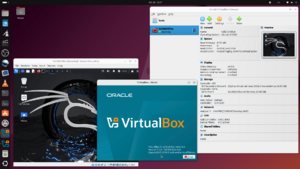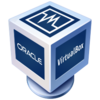VirtualBox facts for kids

VirtualBox logo since 2024
|
|

VirtualBox running on Ubuntu, a type of Linux
|
|
| Original author(s) | InnoTek Systemberatung GmbH (2007–2008) Sun Microsystems (2008–2010) |
|---|---|
| Developer(s) | Oracle Corporation |
| Initial release | 15 January 2007 |
| Stable release | |
| Written in | C, C++, x86 Assembly, Python |
| Operating system | Windows, macOS, Linux and Solaris |
| Platform | x86-64, Apple silicon ARM64 since version 7.1 (version series 5.x and earlier work on IA-32) |
| Type | Virtualization software |
| License |
|
Oracle VirtualBox is a free program that lets you run a "computer inside your computer." This is called a virtual machine or VM.
Imagine you have a Windows computer, but you want to try out Linux. Instead of buying a new computer or changing your current one, you can use VirtualBox to create a virtual Linux computer that runs in a window on your desktop.
VirtualBox can be installed on computers running Microsoft Windows, macOS, and Linux. Inside VirtualBox, you can then install and run many different operating systems, like other versions of Windows, Linux, or even older systems like OS/2. This is great for learning about different operating systems, testing software safely, or running programs that don't work on your main computer.
Contents
A Quick History
VirtualBox was first made in 2007 by a German company called InnoTek. A year later, it was bought by Sun Microsystems, a famous tech company. Then, in 2010, the giant technology company Oracle Corporation bought Sun Microsystems, and the program was renamed Oracle VM VirtualBox.
Over the years, VirtualBox has been updated with many new features.
- Version 4.0 (2010): This version made things simpler. The main program became completely free and open source. An optional "Extension Pack" with extra features was also introduced.
- Version 5.0 (2015): Added support for faster USB3 devices and allowed users to drag and drop files between their main computer and the virtual one.
- Version 6.0 (2018): Introduced a file manager to easily move files and improved graphics for Linux virtual machines.
- Version 7.0 (2022): Added official support for running Windows 11 in a virtual machine, which requires special security features that VirtualBox can now pretend to have.
How Does It Work?
VirtualBox creates a pretend computer, or virtual machine, that uses your real computer's hardware, like its CPU, memory (RAM), and storage. You tell VirtualBox how much memory and storage space the virtual machine can use.
Using Your Computer's Hardware
Modern computers have special technology built into their processors (CPUs) to help run virtual machines smoothly. This is called hardware-assisted virtualization. It allows the virtual machine's operating system to run almost as fast as it would on a real, separate computer. VirtualBox uses this technology from both Intel (called VT-x) and AMD (called AMD-V) to give you the best performance.
Before 2019, if a computer didn't have this special hardware, VirtualBox could use a clever software trick to run VMs, but it was much slower. Now, a computer with hardware virtualization support is required.
Pretend Devices
VirtualBox also creates virtual hardware for your VM.
- Virtual Hard Disks: Your virtual machine's files are stored in a single large file on your computer's hard drive. This file acts like a real hard disk for the VM. VirtualBox can use its own format (VDI) or formats from other virtualization software like VMware (VMDK).
- Virtual CD/DVD Drives: You can use ISO image files as virtual CDs or DVDs. This is how you usually install a new operating system onto a virtual machine.
- Virtual Network Cards: VirtualBox gives your VM a virtual network card so it can connect to the internet through your main computer's connection.
- Virtual USB Ports: You can let your virtual machine use USB devices that are plugged into your real computer, like a flash drive or a webcam.
Cool Features of VirtualBox
VirtualBox has many useful features that make it powerful and easy to use.
- Snapshots: You can save the exact state of your virtual machine at any time. If you make a mistake or a program crashes, you can go back to the saved snapshot in seconds. It's like a time machine for your VM!
- Shared Clipboard and Folders: You can easily copy and paste text between your computer and the virtual machine. You can also set up a shared folder to move files back and forth.
- Seamless Mode: This feature lets you run windows from your virtual machine right on your main desktop. It makes it look like the programs are running on your computer, not inside a VM.
- Screen Recording: You can record a video of what's happening inside your virtual machine, which is great for making tutorials.
- Runs in the Background: You can start a virtual machine and then close the VirtualBox window. The VM will keep running in the background, which is useful for running a server.
Is It Free to Use?
Yes, the main VirtualBox program is free and open source. This means anyone can download, use, and even look at its computer code for free.
There is also a separate VirtualBox Extension Pack that adds extra features, such as:
- Support for faster USB 2.0 and 3.0 devices.
- The ability to encrypt (protect with a password) your virtual machine.
- Letting you control your virtual machine from another computer over a network.
This Extension Pack is free for personal use, for schoolwork, or just to try it out. However, businesses that use it for commercial purposes need to buy a license from Oracle.
Limitations
While VirtualBox is very powerful, it has some limitations.
- 3D Graphics: While it has some support for 3D graphics, it's not powerful enough to play modern, demanding video games. It works best for desktop effects and older games.
- macOS Guests: It's difficult to run macOS in a virtual machine on a non-Apple computer. Apple's license agreement does not allow this, and the operating system checks for real Apple hardware.
- Older Windows: Getting very old versions of Windows, like Windows 98, to work can be tricky on modern computers because of how much CPUs have changed.
See also
 In Spanish: VirtualBox para niños
In Spanish: VirtualBox para niños
- Comparison of platform virtualization software
- Virtual machine
- VMware Workstation
- x86 virtualization



